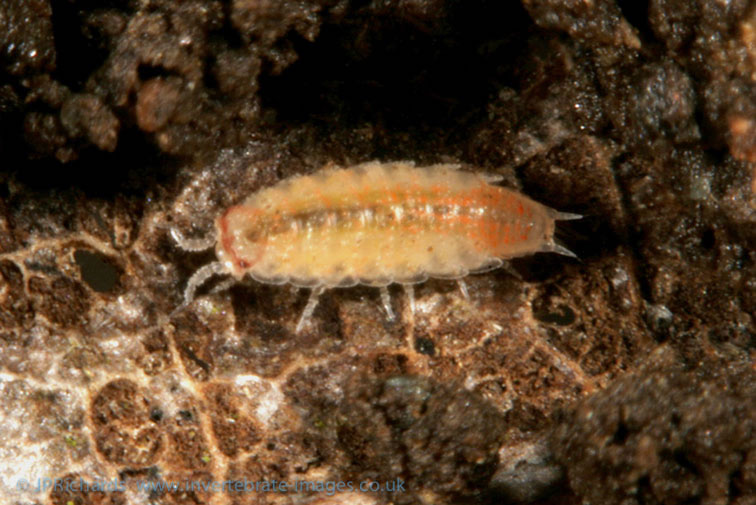Trichoniscoides sarsi Patience, 1908
Common name
Synonyms
- Trichoniscoides sarsi sensu stricto
- Trichoniscoides sarsi seg.
Status:
- GB IUCN status: Least Concern
- GB rarity status: Nationally Scarce
ID Difficulty
Identification
The pygmy woodlice of family Trichoniscidae (and Styloniscidae) are readily distinguished from other woodlice by the shape of the antennal fagellum which comprises a tapered cone (of indistinct segments) bearing a terminal bristle.
Trichoniscoides is a difficult genus and only male specimens of T. sarsi can be distinguished from T. helveticus (or T. saeroeensis). These are small (to 4 mm) creamy-white woodlice flushed with varying amounts of orange with the dorsal surface covered with weak tubercles. In T. sarsi (and T. helveticus) the eye is composed of a single dark red ommatidium (more pinkish orange in T. saeroeensis).
However, all eye and body pigments are rapidly lost in alcohol, thus making preserved specimens difficult to separate from Metatrichoniscoides celticus or M. leydigii.
Males of T. sarsi are readily separated from other British species of Trichoniscoides (and Metatrichoniscoides) by the presence of a hooked projection at the base of the merus of the 7th pereiopod. In addition, the tip of the male 2nd endopod curves outwards and tapers to a curved point (like a sickle blade). These are figured in Gregory (2012), Fig. 2.
Distribution
Although predominantly south-eastern records there are scattered across Britain and into eastern Ireland. An updated distribution map is given in Ashwood & Gregory (2021), Fig. 4. The few available records suggest it has a mutually exclusive distribution with T. helveticus (BMIG Newsletter 4, pg.1); interestingly a situation also seen in the Netherlands (Berg, 2008).
Habitat
Characteristically, it is associated with synanthropic sites, such as old gardens or churchyards (e.g. Richards, 2016), but some coastal sites in Kent and south-west England appear to be semi-natural (e.g. Gregory, 2012; Ashwood & Gregory, 2021). In 2010 specimens were collected from a coastal site in eastern Scotland (BMIG Newsletter 22, pg.2).
Specimens are usually found beneath paving slabs or large stones partially embedded into the soil, but it also may be found among soil or rubble. On the coast it has be found been found at and above the high tide mark, typically under large stones. It is elusive, rarely found in large numbers and probably under-recorded. It often occurs with other trichoniscids, such as Trichoniscus pygmaeus, Haplophthalmus mengii and Trichoniscoides albidus.
This updated summary is based on the detailed account in Gregory (2009), updated in Gregory (2024) (which includes an updated distribution map).
References
Gregory, S.J. (2012) The occurrence of two elusive woodlice, Metatrichoniscoides leydigii (Weber, 1880) and Trichoniscoides sarsi Patience 1908, in semi-natural habitat in Kent. BMIG Bulletin 26.37-40.
Gregory, S. (2009) Woodlice and Waterlice (Isopoda: Oniscidea & Asellota) in Britain and Ireland. Field Studies Council/Centre for Ecology & Hydrology.
Links
World List of Marine, Freshwater and Terrestrial Isopod Crustaceans: https://www.marinespecies.org/isopoda/aphia.php?p=taxdetails&id=263649










